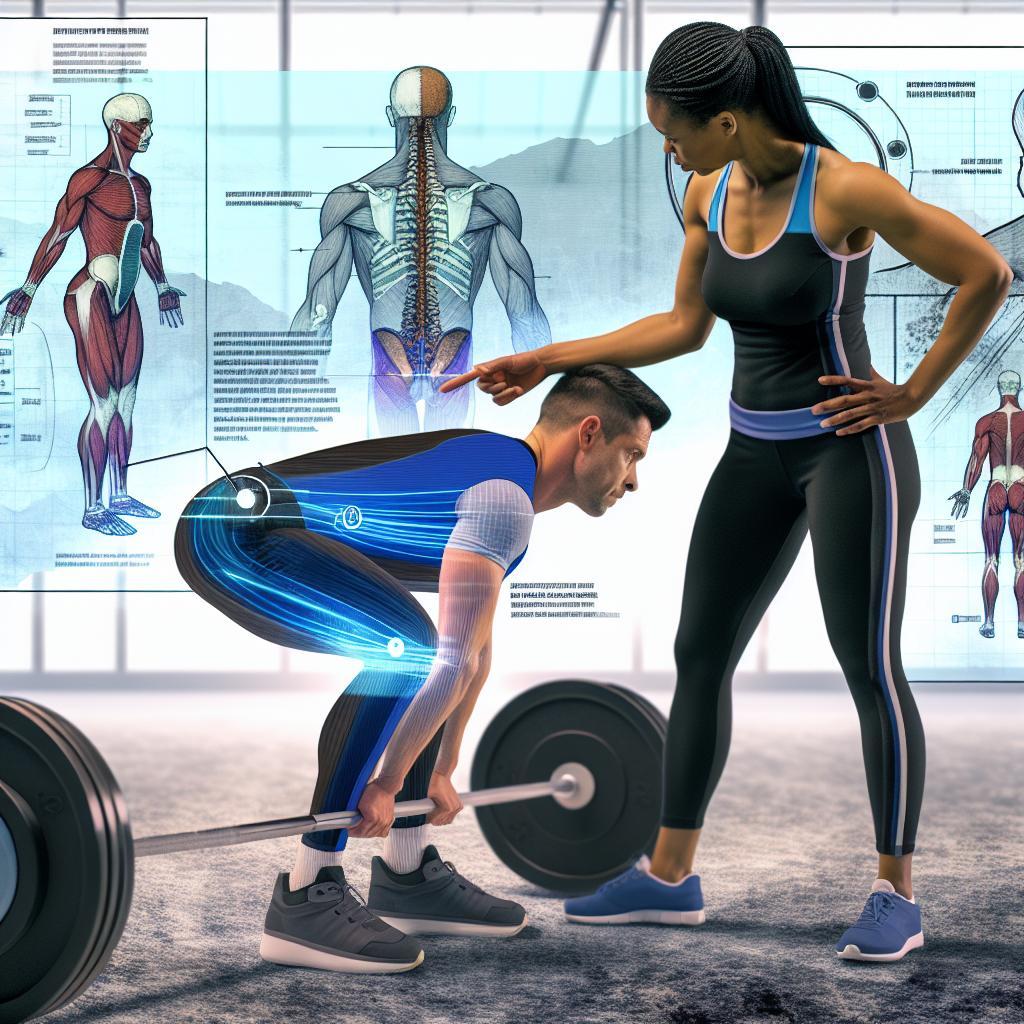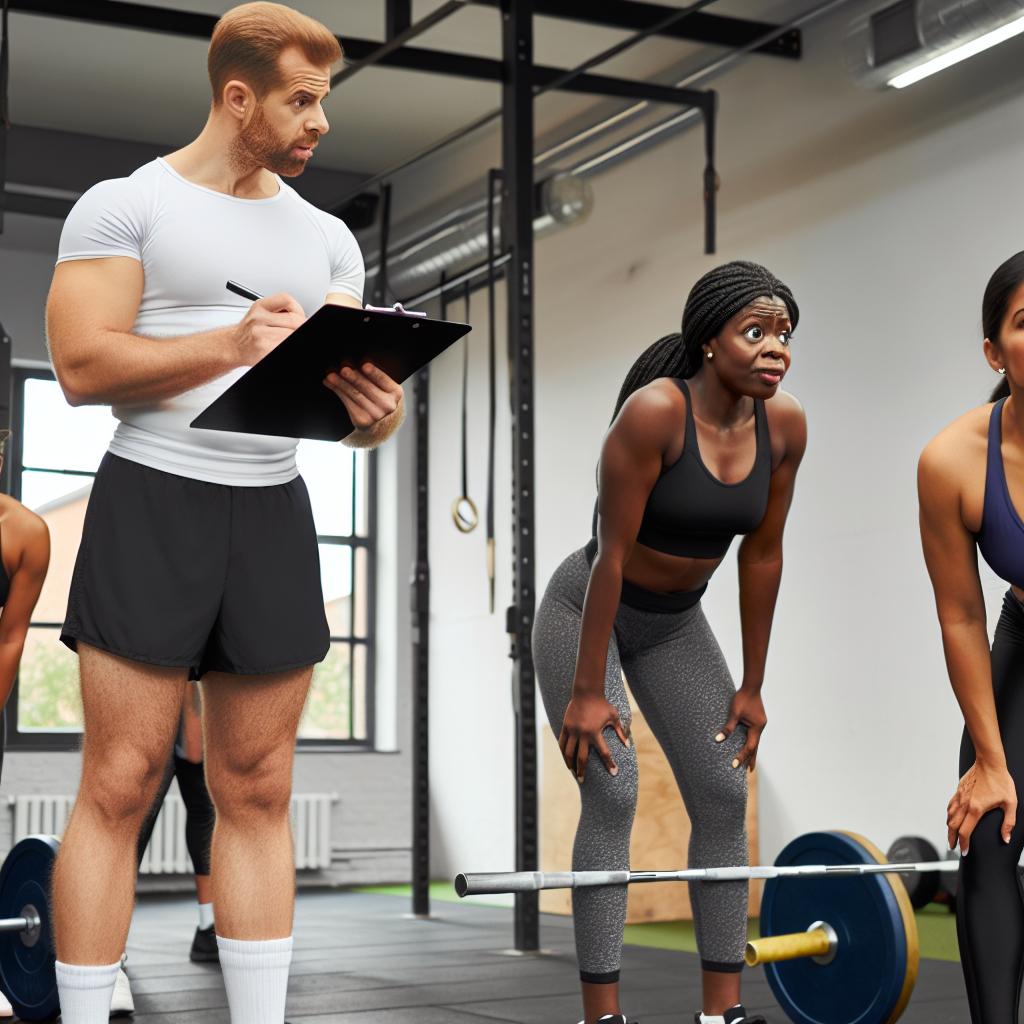When it comes to building a strong, resilient back, one exercise often stands out: the deadlift. This powerful movement engages multiple muscle groups, raising the big question—does it effectively support back health? Understanding its benefits and potential drawbacks is crucial for anyone looking to enhance their strength training routine while ensuring proper form and safety.
## Understanding the Deadlift: An Overview of Its Benefits and Risks
Benefits of the Deadlift
The deadlift is renowned for its ability to enhance overall strength and conditioning, primarily targeting the posterior chain, including the back, hamstrings, and glutes.Here are some key benefits:
- Full-Body Workout: Engages multiple muscle groups, promoting balanced strength across the body.
- Improved Core Stability: Develops core muscles, which are essential for maintaining posture and stability in other exercises.
- Increased functional Strength: Translates well to everyday activities, making it a practical choice for functional training.
- Enhanced Athletic performance: Particularly beneficial for athletes, deadlifts can improve speed, power, and explosiveness in sports.
Risks and Considerations
While the deadlift offers numerous benefits, it also poses certain risks, especially if performed incorrectly. Understanding these risks can help prevent injuries:
- Risk of Injury: Poor form may lead to injuries in the lower back, knees, or shoulders.
- Not Suitable for Everyone: Individuals with pre-existing conditions or injuries should consult with a healthcare professional before attempting deadlifts.
- Requires proper Technique: it’s crucial to learn the correct technique to maximize effectiveness and minimize injury risk. Consider professional coaching if you’re a beginner.
Tips for Safe Deadlifting
To safely integrate deadlifts into your routine, follow these guidelines:
- Start with light weights to master your form.
- Keep your feet shoulder-width apart and grip the bar just outside your knees.
- Engage your core and keep your back straight throughout the movement.
- Drive through your heels to lift the weight and avoid rounding your back.
conclusion
Understanding both the benefits and risks associated with deadlifts can definitely help you make informed decisions about incorporating them into your workout routine. With the right approach and technique, deadlifts can be an effective exercise for building strength in your back and overall body.
## Is Deadlift a Good Back Exercise? Analyzing Muscle Engagement
Muscle Engagement in Deadlifts
The deadlift is often recognized for its overall strength-building capabilities, but its effectiveness as a back exercise is noteworthy. When performed correctly, deadlifts primarily engage the posterior chain, which includes the erector spinae, latissimus dorsi, and various stabilizing muscles in the back.This extensive engagement makes it a formidable exercise for strengthening the back.
Key Muscles Worked
- Erector Spinae: Crucial for spinal extension and stability.
- Latissimus Dorsi: Adds width and strength to the upper back.
- Trapezius: Supports shoulder and neck stability.
- Rhomboids: Crucial for scapular retraction.
Pros and Cons of Deadlifts for Back Strength
While deadlifts can considerably enhance back strength, it’s essential to consider both the advantages and potential drawbacks.
Pros
- Full-Body Engagement: Works multiple muscle groups, providing a comprehensive workout.
- improves Functional Strength: Translates well to everyday movements and athletic performance.
- Enhances Postural Stability: Promotes better posture by strengthening back muscles.
Cons
- Technique-Dependent: Improper form can lead to injuries, especially in the lower back.
- Not Isolated: May not target specific back muscles if focused solely on strength.
To maximize the effectiveness of deadlifts for back engagement, ensure proper technique by keeping a neutral spine and engaging the core throughout the movement. Consider consulting with a trainer to refine your form, particularly if you’re a beginner or returning after an injury.
## The Pros of Deadlifting for Back Strength and Development
Comprehensive Muscle Engagement
Deadlifting is one of the most effective exercises for enhancing back strength and development. It engages multiple muscle groups, particularly the posterior chain, which includes the lower back, glutes, and hamstrings. this compound movement not only strengthens the back muscles but also promotes overall stability and posture. The deadlift’s ability to target key muscles helps build muscle mass and provides a robust foundation for other lifts and physical activities.
Benefits for Back Development
- Increases Muscular Endurance: Regularly incorporating deadlifts into your workout routine can significantly enhance your muscular endurance, allowing your back to withstand greater loads over time.
- Improves Posture: A strong back contributes to better posture, reducing the risk of injury and enhancing overall performance in daily activities.
- Aids in Core Stability: Deadlifts require core engagement,which helps stabilize the spine during various physical tasks,thus promoting overall back health.
Enhanced Functional Strength
Deadlifts also play a crucial role in building functional strength, which translates well into real-life movements. By mimicking the natural lifting motions we perform every day, deadlifts improve your ability to lift heavy objects safely, reducing the risk of injury. This functional training aspect is beneficial for everyone, from athletes to those with physically demanding jobs.
Step-by-Step Deadlift Technique
- Stand with Feet Hip-Width Apart: Position your feet under the barbell, ensuring it’s close to your shins.
- Grip the Bar: Bend at the hips and knees to grip the bar with hands just outside your knees.
- Set Your Back: Keep your chest up and back flat, engaging your lats.
- Lift Off: Drive through your heels, extend your hips and knees simultaneously, and stand tall.
- Lower the Weight: Reverse the movement by hinging at the hips and bending your knees, keeping the bar close to your body.
By following these pointers and engaging in consistent deadlifting practice, you can expect improved back strength and a well-rounded muscular development that supports various physical demands.
## The Cons of Deadlifting: Risks and Common Mistakes
Risks of Deadlifting
While the deadlift is a highly effective exercise for developing strength, it also comes with potential risks that need to be addressed. Injuries frequently enough stem from improper form, excessive weight, or lack of preparation. Here are some common risks associated with deadlifting:
- Lower Back Injury: Poor technique can lead to significant strain on the lower back, resulting in pain or injury.
- Knee Pain: Improper alignment can put undue pressure on the knees during the lift.
- Muscle Strain: Lifting too much weight too quickly can cause muscle strains, especially in the hamstrings and glutes.
Common Mistakes to Avoid
to maximize the benefits of deadlifting while minimizing risks, it’s crucial to recognize and avoid common mistakes:
- Improper Loading: Many lifters add weight too quickly, increasing their risk of injury. Gradually progress to higher weights rather.
- Form Degradation: Ensure proper posture throughout the lift. Your back should remain straight while bending at the hips and knees.
- Neglecting Warm-ups: Skipping warm-up exercises can lead to stiff muscles, increasing the likelihood of strains.
Preventative Measures
Incorporating effective warm-up routines and proper lifting techniques can significantly reduce the risks associated with deadlifting:
Warm-up Routine:
- Dynamic Stretches: engage in dynamic stretches targeting the legs, hips, and lower back to enhance flexibility.
- Light Sets: Perform several light sets before moving to heavier weights to prepare your muscles.
- Check Your Form: Use mirrors or a spotter to ensure your form is correct, focusing on hip hinge mechanics.
## Practical Solutions for Safely Incorporating Deadlifts into Your Routine
Understanding Proper Form
To safely incorporate deadlifts into your routine, mastering proper form is paramount. A deadlift primarily engages the back, hips, and legs, so executing it correctly minimizes the risk of injury. To achieve this:
- Set Your Feet: Stand with your feet hip-width apart, positioning your toes slightly outward.
- Grip the Bar: Bend at the hips and knees to grip the bar,placing your hands just outside your knees.
- Lift with Your Legs: Initiate the lift by driving through your heels while keeping your back straight and chest up.
- Finish Strong: Stand tall at the top, engaging your core before lowering the bar back down with control.
Practice with lighter weights until you feel confident in your form to ensure a solid foundation for heavier lifts.
Incorporating Deadlifts in Your Routine
When adding deadlifts to your workout, consider the following strategies to manage fatigue and optimize performance:
- Frequency: Limit deadlifts to 1-2 times per week to allow adequate recovery.
- Placement: Schedule deadlifts at the beginning of your workout when your energy levels are highest.
- Variations: Mix traditional deadlifts with variations such as sumo or Romanian deadlifts to target different muscle groups while reducing the risk of overuse injuries.
Warm-Up and Recovery
Prioritize warming up and cooling down around your deadlift sessions:
- Dynamic Warm-Up: Engage in dynamic stretches like leg swings and hip circles to prepare your muscles.
- Post-Workout Stretches: Incorporate stretches for the hamstrings, back, and hips to enhance flexibility and support recovery.
By integrating these practical solutions, you can effectively and safely enjoy the benefits of deadlifts in your back training routine.
## Essential Warm-Up Exercises to Support Your Deadlifting Efforts
Dynamic Warm-Up Sequence
Before progressing to deadlifts, it’s crucial to engage in a dynamic warm-up that prepares your entire body. This routine not only increases blood flow but also enhances your range of motion,reducing the risk of injury. Aim for about 15 to 20 minutes for optimal results. Here are essential exercises to include:
- Light Cardio: Start with 5-10 minutes of light cardio to get your heart rate up. Options include jogging, cycling, or skipping.
- Dumbbell or Bodyweight Squats: Perform 2 sets of 10-15 reps to activate your legs and core.
- Hip Hinges: Practice the hip hinge movement to reinforce the deadlifting motion. Do 2 sets of 10 reps using light weights.
Targeted Mobility Exercises
Along with a general warm-up, include specific mobility exercises targeting the back, hips, and shoulders:
- Cat-Cow Stretches: Focus on spinal mobility. Perform 10 reps, alternating arching and rounding your back.
- Thoracic Rotations: while on all fours, rotate your upper body while keeping the lower body stable. Complete 5-10 reps on each side.
- Glute Bridges: Activate your glutes by doing 2 sets of 10-15 reps, focusing on squeezing at the top of the movement.
Practice Reps with Light Weights
As the final part of your warm-up, it’s beneficial to practice deadlift movements with lighter weights. this technique helps in reinforcing form and increasing neural activation:
- Light Deadlifts: use about 40-50% of your usual working weight. Perform 2-3 sets of 5-8 reps.
- Focus on Techniqu: Concentrate on proper form, maintaining a neutral spine, and engaging your core throughout the lift.
## Stretching Techniques to alleviate Tension After Deadlifting
Essential Stretches for Recovery
After performing deadlifts, it’s crucial to engage in stretching techniques that help relieve muscle tension and promote recovery. Incorporate the following stretches into your post-workout routine:
- Hamstring Stretch: Sit on the floor with one leg extended and the other bent. Reach towards your toes while keeping your back straight. Hold for 20-30 seconds.
- Hip Flexor Stretch: Kneel on one knee with the other foot in front, forming a right angle.Push your hips forward to feel the stretch in your hip flexor. Hold for 20-30 seconds on each side.
- Lower Back Stretch: Lie on your back, pull your knees to your chest, and gently rock side to side. This helps relieve tightness in the lower back.
Recommended stretching Techniques
To effectively alleviate tension after deadlifting,consider the following techniques:
- Static Stretching: Ideal for post-workout as it helps in lengthening muscles and reducing stiffness. Always hold stretches for a minimum of 20 seconds.
- Dynamic Stretching: Engage in light movements that mimic stretches to improve blood flow. Examples include leg swings or gentle torso twists.
- Foam Rolling: Use a foam roller on your back, hamstrings, and glutes to release tightness and improve flexibility.
Sample Post-Deadlift Stretch Routine
For a comprehensive recovery, incorporate this quick routine:
| Stretch | Duration | Repetitions |
|---|---|---|
| Hamstring Stretch | 20-30 seconds | 2-3 times per leg |
| Hip flexor Stretch | 20-30 seconds | 2-3 times per side |
| Lower Back Stretch | 30 seconds | 2-3 times |
Implement these stretching techniques after your deadlift sessions to enhance recovery and minimize muscle tension. Remember, listening to your body and adjusting stretches as needed is essential for optimal results.
## Tips for Modifying Deadlifts Based on Skill Level and Experience
Understanding deadlift Modifications
Deadlifts are a versatile exercise that can be tailored to fit various skill levels and experiences. Modifying your deadlift technique can help ensure safety and accuracy, which is crucial for achieving desired outcomes while minimizing the risk of injury.
Beginners
- Start with a lighter weight: Begin with a weight that feels manageable, focusing on form rather than heavy lifting.
- Use a modified range of motion: Start with variations like the Romanian deadlift or kettlebell deadlift to develop strength gradually.
- Incorporate assistance exercises: strengthen your back and core with exercises like planks, glute bridges, and hip thrusts.
Intermediate lifters
- Increase weights progressively: Gradually increase the load while maintaining proper technique to enhance muscle development.
- Experiment with stances: Try sumo or trap bar deadlifts to find a comfortable position that targets different muscle groups.
- Include deficit deadlifts: Standing on a platform increases the range of motion, helping to develop strength in your lifts.
Advanced Lifters
- Focus on speed work: Incorporate speed deadlifts at lighter weights to improve bar speed and technique.
- Utilize specificity training: Implement specific variations, such as paused deadlifts, to improve strength in weak points of your lift.
- Integrate different grips: Alternate between conventional, mixed, or hook grips to enhance grip strength and stability during your lifts.
## Evaluating Your Progress: When to Adjust Your Deadlift Approach
Recognizing Signs of Stagnation
As you progress in your deadlift routine, it’s essential to regularly assess your performance and recognize signs that may indicate the need for an adjustment. Look for the following indicators:
- Plateaus: if you’ve been lifting the same weight for several sessions without enhancement, it might be time to reevaluate your approach.
- Fatigue: Persistent fatigue or soreness could signal overtraining or inadequate recovery.
- Form Deterioration: If your form starts to slip during lifts, it’s crucial to reassess your technique and perhaps reduce weight.
Strategies for Adjusting Your Approach
When you identify the need for a change, consider implementing one or more of the following strategies:
Change Your Set/Rep Scheme
Switching your set and rep range can effectively stimulate progress:
- For strength gains, try 3-5 sets of 3-5 reps with heavier weights.
- If focusing on hypertrophy, aim for 4-6 sets of 8-12 reps with moderate weights.
Incorporate Accessory Work
Adding accessory exercises can definitely help target specific weaknesses:
- Consider exercises like Romanian deadlifts, barbell rows, or back extensions to strengthen supporting muscles.
- Utilizing bands or chains may also enhance your power and stability during lifts.
Rest and Recovery
Don’t underestimate the role of recovery. Ensure you’re:
- Allowing adequate rest days between intense deadlift sessions.
- Practicing active recovery techniques, including gentle stretching or foam rolling.
Q&A
### Is the Deadlift Effective for Building Back Strength?
The deadlift is widely recognized as one of the most effective exercises for enhancing back strength. It primarily targets the **latissimus dorsi**, **erector spinae**, and other stabilizing muscles in your back. When performed correctly, deadlifts create a significant load on these muscles, resulting in increased muscle mass and strength.
**Benefits for Your Back:**
– **Comprehensive Muscle Engagement:** Deadlifts engage multiple muscle groups, including the lower back, upper back, and core, making it a compound exercise that effectively fortifies your back.
– **Functional Strength:** The deadlift mimics real-life lifting movements, contributing to improved functional strength that translates to everyday tasks, reducing the risk of back injuries.
However, it’s crucial to maintain proper form to avoid injury. Potential risks include a rounded back or lifting too heavy too soon, which can lead to muscle strain or more severe injuries.
### What Are the Pros of Deadlifts for the Back?
The pros of incorporating deadlifts into your workout routine are substantial:
– **Strength Gains:** Regularly performing deadlifts can lead to significant strength gains. A study indicates that compound lifts like the deadlift can produce greater overall strength improvements compared to isolation exercises.
– **Muscle Hypertrophy:** Deadlifts promote muscle growth in the back due to the heavy loading of muscle fibers involved, leading to enhanced hypertrophy.
Additionally, the overall benefits of deadlifts extend beyond just the back. They can also improve core stability, boost athletic performance, and enhance body posture, contributing to a balanced physique.
### Are There any Cons to Consider for Deadlifts?
While deadlifts offer numerous benefits, there are some cons to be aware of:
– **Risk of Injury:** If not executed with proper form, deadlifts can lead to back injuries, including herniated discs. This emphasizes the necessity of learning correct technique and possibly seeking guidance from fitness professionals.
– **Equipment Needs:** To perform deadlifts safely and effectively, appropriate equipment (like a barbell and weights) is required, which may not be accessible to everyone.
It’s essential to understand your body and its limits. If you have existing back issues or concerns, consult with a healthcare professional before incorporating deadlifts into your routine.
### How Can I Ensure Proper Form when Deadlifting?
Proper form is critical when performing deadlifts. Here is a step-by-step guide to maintaining good technique:
1. **Setup:**
– stand hip-width apart with your feet under the barbell.
– Grip the bar just outside your knees, ensuring your arms are straight.
2. **Starting Position:**
– Keep your back flat and chest up.
– Engage your core and ensure your hips are slightly higher than your knees.
3. **Lift:**
– Push through your heels while keeping the bar close to your body.
– Extend your hips and knees simultaneously.
4. **Finish:**
- stand tall at the top,pulling your shoulders back.
- Lower the bar back down with control, reversing the movement.
always start with lighter weights to perfect your form.Consider working with a trainer initially to correct alignment and technique.
### Can Deadlifts Benefit Those with Preexisting Back Conditions?
For individuals with preexisting back conditions, deadlifts can still be beneficial when approached cautiously. However, individualized modifications and understanding one’s limits are key.
– **Consultation:** Always consult with a healthcare provider before starting any lifting regimen, especially if you have a history of back pain or structural issues.
– **Modification Options:** For those unable to perform standard deadlifts,alternatives like **trap bar deadlifts** or **dumbbell deadlifts** can be less stressful on the lower back.
Incorporating mobility work and flexibility exercises can also support back health,allowing you to benefit from the strength gains associated with deadlifting.### How Often Should I Include Deadlifts in My training Routine?
The frequency of deadlifting can depend on your experience level and overall training goals. Here are some guidelines:
– **Beginners:** Starting with deadlifts once a week is generally recommended. Focus on form and gradual progression.
– **Intermediate to Advanced Lifters:** Experienced lifters may benefit from deadlifting 1-2 times per week, varying intensities and volume based on their training programs.
It’s essential to listen to your body and incorporate recovery days, as deadlifting can be taxing on the back and central nervous system. Adequate rest will support muscle recovery and growth, ensuring continued progress without overtraining.
### What Are Some Alternatives to Deadlifts for Back Training?
If deadlifts aren’t suitable due to personal preference, equipment availability, or injury concerns, there are several excellent alternatives:
– **Bent-over Rows:** target the upper and middle back while allowing for a similar muscle engagement approach without the same load on the spine.
– **Hyperextensions:** Focus on the lower back and can be performed on a bench or machine,adding variation without heavy barbell loads.- **Kettlebell Swings:** Excellent for developing explosive power in the posterior chain while offering a dynamic movement pattern.
Including a variety of exercises can contribute to a well-rounded back training regimen, ensuring balanced muscle development and minimizing injury risk.
Future Outlook
### Final Thoughts on Deadlifts as a Back exercise
As we wrap up our exploration of whether deadlifts are a good back exercise,it’s important to recap the main points we’ve covered.
#### Key Takeaways:
– **Benefits of Deadlifting:**
– Engages multiple muscle groups, particularly targeting the back, hamstrings, and glutes.
– Improves overall strength and stability, making it functional for daily activities.
– Can enhance athletic performance in sports that require explosive power.
- **Considerations:**
- Proper form is crucial to avoid injury; incorrect technique can lead to strains, particularly in the lower back.
– Individual fitness levels and pre-existing conditions should guide your decision to incorporate deadlifts into your routine.
### Action Steps:
1. **Assess Your Fitness Level:**
– if you’re new to deadlifting, consider starting with lighter weights or seeking guidance from a professional trainer.
2. **Focus on Form:**
– Use resources like instructional videos or articles to master the technique before progressing in weight.
3. **Listen to Your Body:**
– Pay attention to how your back feels during and after the lift. If you experience pain, reassess your technique or consult a fitness expert.
4. **Incorporate Variety:**
- Remember that deadlifts are just one tool in your fitness toolbox. Explore other back exercises to find what works best for you.
#### Conclusion
Deadlifts can be an excellent addition to your workout routine, especially for building back strength, but they must be approached thoughtfully. Armed with the knowledge of their pros and cons,you’re well-equipped to make an informed decision about incorporating deadlifts into your fitness regimen. So harness that enthusiasm, practice safely, and enjoy the journey to a stronger back! Happy lifting!











